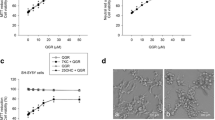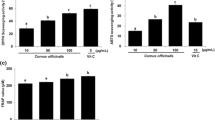Abstract
The cytotoxicity of the oxysterols 25-hydroxycholesterol, 7β-hydroxycholesterol, cholesterol-5α,6α-epoxide, cholesterol-5β,6β-epoxide, 19-hydroxycholesterol and 7-ketocholesterol was examined in U937 cells, a human monocytic blood cell line. 7β-Hydroxycholesterol, cholesterol-5β,6β-epoxide, and 7-ketocholesterol, at 30 μmol/L concentration, were found to be cytotoxic to this cell line and the mode of cell death was by apoptosis. 25-Hydroxycholesterol, cholesterol-5α,6α-epoxide and 19-hydroxycholesterol (30 μmol/L) did not induce apoptosis in this cell line. Since it has been suggested that the generation of an oxidative stress may occur in the early stages of the apoptotic process, the glutathione concentration and the activity of superoxide dismutase were also measured in the oxysterol-treated cells. 7β-Hydroxycholesterol was shown to increase the superoxide dismutase activity and decrease the glutathione concentration. However, cholesterol-5β,6β-epoxide and 7-ketocholesterol, which were also shown to induce apoptosis, did not affect the glutathione concentration or the superoxide dismutase activity in the U937 cells. Therefore, oxysterol-induced apoptosis may not be dependent on the generation of an oxidative stress.
Similar content being viewed by others
References
Aupeix K, Weltin D, Mejia JE, et al. Oxysterol-induced apoptosis in human monocytic cell lines. Immunobiology. 1995;194:415–28.
Berliner JA, Heinecke JW. The role of oxidised lipoproteins in atherogenesis. Free Radic Biol Med. 1996;20:707–27.
Best PJM, Hasdai D, Sangiorgi G, et al. Apoptosis: basic concepts and implications in coronary artery disease. Arterioscler Thromb Vasc Biol. 1999;19:14–22.
Briehl MM, Cotgreave IA, Powis G. Downregulation of the antioxidant defence during glucocorticoid-mediated apoptosis. Cell Death Differ. 1995;2:41–6.
Brown AJ, Leong S, Dean RT, Jessup W. 7-Hydroperoxy-cholesterol and its products in oxidised low density lipoprotein and human atherosclerotic plaque. J Lipid Res. 1997;38:1730–45.
Cantwell H, Devery R. The response of the antioxidant defence system in rat hepatocytes challenged with oxysterols is modified by Covi-ox. Cell Biol Toxicol. 1998;14:401–9.
Deckert V, Brunet A, Lantoine F, et al. Inhibition by cholesterol oxides of NO release from human vascular endothelial cells. Arterioscler Thromb Vasc Biol. 1998;18:1054–60.
Dubrez L, Savoy I, Hamman A, Solary E. Pivotal role of a DEVD-sensitive step in etoposide-induced and Fasmediated apoptotic pathways. EMBO J. 1996;15:5504–12.
Emanuel HA, Hassel CA, Addis PB, Bergman SD, Zavoral JH. Plasma cholesterol oxidation products (or sterols) in human subjects fed a meal rich in oxysterols. J Food Sci. 1991;56:843–7.
Fielding CJ, Bist A, Fielding PE. Cavcolin mRNA levels are up-regulated by free cholesterol and down-regulated by oxysterols in fibroblast monolayers. Proc Natl Acad Sci USA. 1997;94:3753–8.
Garner B, Jessup W. Cell-mediated oxidation of low density lipoprotein: the elusive mechanism(s). Redox Rep. 1996;2:97–104.
Ghibelli L, Coppola S, Rotilio G, Lafavia E, Maresca V, Ciriolo MR. Non-oxidative loss of glutathione in apoptosis via GSH extrusion. Biochem Biophys Res Commun. 1995;216:313–20.
Ghibelli L, Fanelli C, Rotilio G, et al. Rescue of cells from apoptosis by inhibition of active GSH extrusion. FASEB J. 1998;12:479–86.
Ghibelli L, Coppola S, Fanelli C, et al. Glutathione depletion causes cytochrome c release event in the absence of cell commitment to apoptosis. FASEB J. 1999;13:2031–6.
Harada-Shiba M, Kinoshita M, Kamido H, Shimokado K. Oxidised low density lipoprotein induces apoptosis in cultured human umbilical vein endothelial cells by common and unique mechanisms. J Biol Chem. 1998;273:9681–7.
Hennig B, Boissonneault GA. Cholestan-3β,5α,6β-triol decreases barrier function of cultured endothelial cell monolayers. Atherosclerosis. 1987;68:255–61.
Higley NA, Taylor SL. The steatotic and cytotoxic effects of cholesterol oxides in cultured L cells. Food Chem Toxicol. 1984;22:983–92.
Hissin PJ, Hilf R. A fluorometric method for determination of oxidised and reduced glutathione in tissues. Anal Biochem. 1976;74:214–26.
Kilsdonk EPC, Morel DW, Johnson WJ, Rothblat GH. Inhibition of cellular cholesterol efflux by 25-hydroxycholesterol. J Lipid Res. 1995;36:505–16.
Linseisen J, Wolfram G. Origin, metabolism and adverse health effects of cholesterol oxidation products. Fett/Lipid. 1998;100:211–18.
Lizard G, Deckert V, Dubrez L, Moisant M, Gambert P, Lagrost L. Induction of apoptosis in endothelial cells treated with cholesterol oxides. Am J Pathol. 1996;148:1625–38.
Lizard G, Gueldry S, Sordet O, et al. Glutathione is implied in the control of 7-ketocholesterol-induced apoptosis, which is associated with radical oxygen species production. FASEB J. 1998;12:1651–63.
Mahfouz MM, Kawano H, Kummerow FA. Effect of cholesterol-rich diets with and without added vitamins E and C on the severity of atherosclerosis in rabbits. Am J Clin Nutr. 1997;66:1240–9.
Matthias D, Becker CH, Godicke W, Schmidt R, Ponsold K. Action of cholestane-3β,5α,6β-triol on rats with particular reference to the aorta. Atherosclerosis. 1987;63:115–24.
Miguet C, Monier S, Bettaieb A, et al. Ceramide generation occurring during 7β-hydroxycholesterol-induced apoptosis is caspase independent and is not required to trigger cell death. Cell Death Differ. 2001;8:83–99.
Misra HP, Fridovich I. Superoxide dismutase: a photochemical augmentation assay. Arch Biochem Biophys. 1977;181:308–12.
Mowles JM. Mycoplasma detection. In: Pollard JW and Walker JM, eds. Methods in molecular biology, Volume V, Animal cell culture. Humana Press, Clifton, NJ; 1990:65–74.
O'Callaghan YC, Woods JA, O'Brien NM. Oxysterol-induced cell death in U937 and HepG2 cells at reduced and normal serum concentrations. Eur J Nutr. 1999;38:255–62.
Osada K, Sasaki E, Sugano M. Lymphatic absorption of oxidised cholesterol in rats. Lipids. 1994;29:555–9.
Peng SK, Taylor CB. Cholesterol autoxidation, health and atherosclerosis. World Rev Nutr Diet. 1984;44:117–54.
Peter ME, Krammer PH. Mechanisms of CD95 (APO-1/Fas)-mediated apoptosis. Curr Opin Immunol. 1998;10:545–51.
Peterson AR, Peterson H, Spears CP, Trosko JE, Sevanian A. Mutagenic characterization of cholesterol epoxides in Chinese hamster V79 cells. Mutat Res. 1988;203:355–66.
Rong JX, Shen L, Chang Y, Richters A, Hodis HN, Sevanian A. Cholesterol oxidation products induce vascular foam cell lesion formation in hypercholesterolemic New Zealand white rabbits. Arterioscler Thromb Vasc Biol. 1999;19:2179–88.
Sevanian A, Berliner J, Peterson H. Uptake, metabolism, and cytotoxicity of isomeric cholesterol-5,6-epoxides in rabbit aortic endothelial cells. J Lipid Res. 1991;32:147–55.
Smith PK, Krohn RI, Hermanson GT, et al. Measurement of protein using bicinchoninic acid. Anal Biochem. 1985;150:76–85.
Strauss GHS. Non-random cell killing in cryopreservation: implications for performance of the battery of leukocyte tests (BLT), I. Toxic and immunotoxic effects. Mutat Res. 1991;252:1–15.
Therond P, Abella A, Laurent D, et al. In vitro study of the cytotoxicity of isolated oxidised lipid low-density lipoproteins fractions in human endothelial cells: relationship with the glutathione status and cell morphology. Free Radic Biol Med. 2000;28:585–96.
Zieden B, Kaminskas A, Kristenson M, et al. Increased plasma 7β-hydroxycholesterol concentrations in a population with a high risk for cardiovascular disease. Arterioscler Thromb Vasc Biol. 1999;19:967–71.
Author information
Authors and Affiliations
Rights and permissions
About this article
Cite this article
O'Callaghan, Y., Woods, J. & O'Brien, N. Comparative study of the cytotoxicity and apoptosis-inducing potential of commonly occurring oxysterols. Cell Biol Toxicol 17, 127–137 (2001). https://doi.org/10.1023/A:1010914306375
Issue Date:
DOI: https://doi.org/10.1023/A:1010914306375




